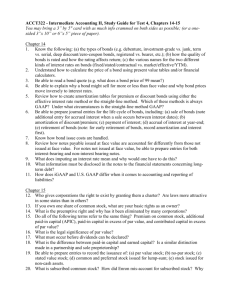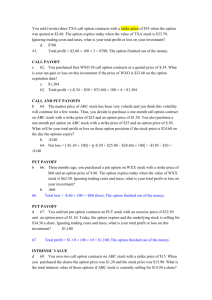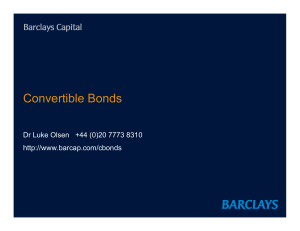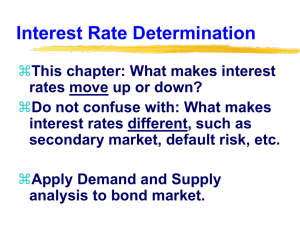Chapter 10: Bonds and Equity Characteristics and Valuation
advertisement
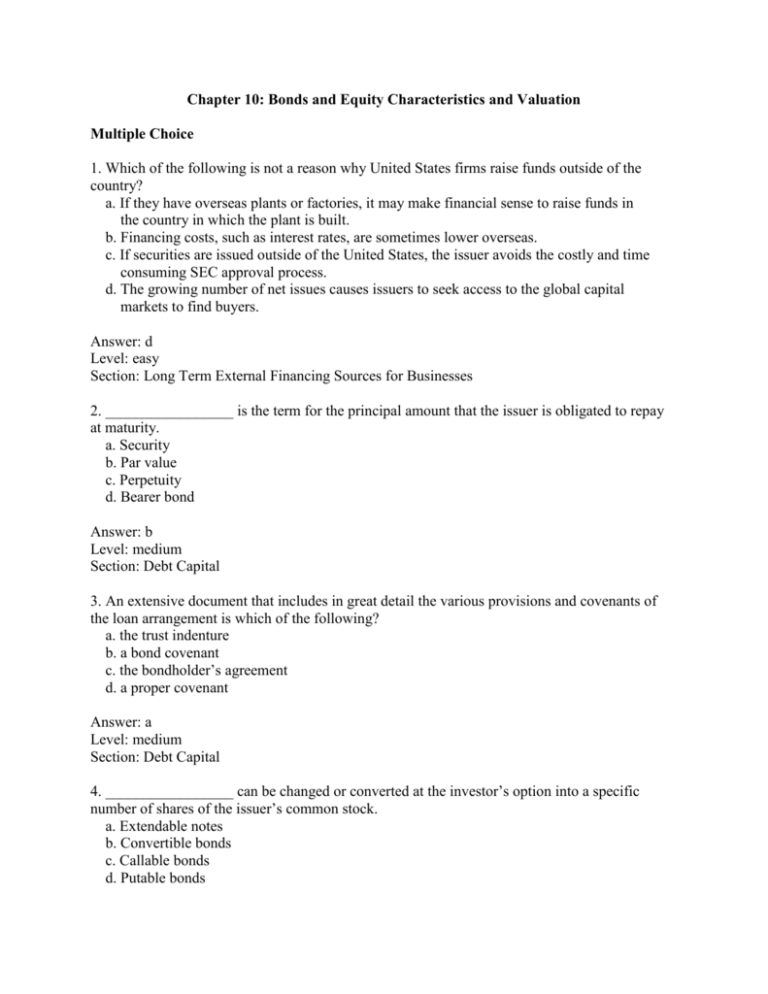
Chapter 10: Bonds and Equity Characteristics and Valuation Multiple Choice 1. Which of the following is not a reason why United States firms raise funds outside of the country? a. If they have overseas plants or factories, it may make financial sense to raise funds in the country in which the plant is built. b. Financing costs, such as interest rates, are sometimes lower overseas. c. If securities are issued outside of the United States, the issuer avoids the costly and time consuming SEC approval process. d. The growing number of net issues causes issuers to seek access to the global capital markets to find buyers. Answer: d Level: easy Section: Long Term External Financing Sources for Businesses 2. _________________ is the term for the principal amount that the issuer is obligated to repay at maturity. a. Security b. Par value c. Perpetuity d. Bearer bond Answer: b Level: medium Section: Debt Capital 3. An extensive document that includes in great detail the various provisions and covenants of the loan arrangement is which of the following? a. the trust indenture b. a bond covenant c. the bondholder’s agreement d. a proper covenant Answer: a Level: medium Section: Debt Capital 4. _________________ can be changed or converted at the investor’s option into a specific number of shares of the issuer’s common stock. a. Extendable notes b. Convertible bonds c. Callable bonds d. Putable bonds Answer: b Level: medium Section: Time to Maturity 5. What is the term for dollar denominated bonds that are issued in the United States by a foreign issuer? a. callable bonds b. convertible bonds c. Yankee bonds d. Eurodollar bonds Answer: c Level: difficult Section: Global Bond Market 6. Financial capital supplied by the owners of a corporation is the definition of ____________. a. common stock b. stock certificates c. convertible bonds d. corporate equity capital Answer: d Level: difficult Section: Corporate Equity Capital 7. Common stock ownership allows each investor to __________________________. a. vote on the corporation’s board of directors. b. be involved with management decisions on a day to day basis. c. vote directly on the dividend declaration decision each quarter. d. receive priority over bondholders in the case of liquidation. Answer: a Level: medium Section: Common Stock 8. What is the main advantage of owning bonds over stock in a firm? a. higher returns over time b. voice in the management of the firm c. priority claim on the firm’s cash flows and assets d. guaranteed quarterly dividend payments over the life of the bond Answer: c Level: difficult Section: Debt Capital 9. Which of the following is not a common element of a preferred stock? a. The par value is meaningful. b. No voting rights unless dividends are missed. c. represents an ownership claim d. Claim on assets and cash flow lies between the bondholders and common share holders. Answer: c Level: difficult Section: Common Stock 10. What is the common term that is used when the firm distributes additional shares for every share owned? a. special dividend b. stock split c. stock dividend d. reverse split Answer: b Level: difficult Section: Stock Dividends and Stock Splits 11. A 2 for 1 stock split gives the stockholder _______________________________. a. twice as many shares at double the previous price. b. twice as many shares at half the previous price. c. half as many shares at twice the previous price. d. half as many shares at double the previous price. Answer: b Level: medium Section: Stock Dividends and Stock Splits 12. Firms tend to repurchase shares for all of these reasons except a. repurchasing shares allows the investor to gain value without incurring immediate taxation. b. repurchasing shares is a good investment of the firm’s capital. c. repurchasing shares allows the firm to distribute excess cash to its shareholders. d. repurchasing shares provides a way for management to end the threat that dissident shareholders may provide to the current management team. Answer: d Level: difficult Section: Share Repurchases 13. In the present value formula, the value or current price should equal what? a. the present value of expected future cash flows b. the projected cash inflows c. securities issued d. future value Answer: a Level: difficult Section: Valuation Principles 14. The chance of nonpayment or delayed payment of interest or principal is the definition of ____________ risk. a. credit b. interest rate c. political d. exchange rate Answer: a Level: medium Section: Credit Risk 15. A bond that is selling below par value is referred to as what kind of bond? a. a junk bond b. a premium bond c. a discount bond d. a convertible bond Answer: c Level: medium Section: Valuation of Bonds

